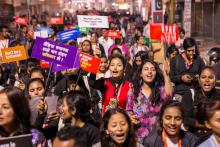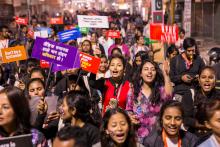Less than 1 per cent of aid spending targets gender-based violence, according to new reports
The collective calls for USD 500 million in new funding against gender-based violence for low- and middle-income countries by 2026.
“Understanding who is funding prevention, where this funding is going, and what impact this funding is having helps build a picture that can inform and guide future decision-making and investment”, said Emma Fulu, Founder and Executive Director of the Equality Institute.
She described the report as “an invitation” to funders across the globe to redouble their efforts and continue to help drive investment in preventing gender-based violence.
A separate report, the Action Coalition on GBV’s Accountability Report, noted that only 5 per cent of total overseas development assistance dedicated to addressing violence against women reached civil society organizations in developing countries, thereby highlighting the urgent need for increased long-term, sustainable investments in women’s rights organizations.
Recommendations
The “What Counts?” report calls for shifts in funding distribution, recommending governments directly fund local women’s rights organizations and feminist movements. At present, 98 per cent of funding has been delivered to international nongovernmental organizations, private contractors, governments, and multilateral agencies—and that funding is often short-term and focused on delivering specific projects.
Instead, the report says, funding should be sent to front-line feminist organizations and independent global feminist funds, which can be more flexible in the disbursing of funds and focus on long-term goals.
Another recommendation is for private philanthropic foundations to commit to gender-based violence prevention in their overall strategic plans, and to embed such commitments across their portfolios. Philanthropies are also encouraged to provide annual reports on their investments fighting gender-based violence, and all donors are recommended to increase the transparency of their programmes to ensure that progress can be tracked.
The report also recommends that plans to reduce gender-based violence be built into international development policies, counties’ national action plans, and broader strategies at the country level. Governments are encouraged to enact multi-sectoral national action plans to prevent gender-based violence, with budgets that include commitments for aid and international development.
The Action Coalition on GBV’s Accountability Report also calls for increasing funding to women’s rights organization and for doubling the amount of funds that reach local women’s rights organizations. That report also calls for coordinated, comprehensive, and multi-sectoral programming on violence against women and girls.
“It is possible to end this global scourge in our lifetime”, said Kalliopi Mingeroi, Chief of UN Women’s Ending Violence against Women and Girls Section. “We have the answer: sustained political commitment and greater investments in effective prevention strategies through domestic financing, official development assistance, private and philanthropic financing can drive down the prevalence of violence against women and girls in all their diversity”.
“Every effort invested in prevention is a step towards a safer and more equal world”, she said.

